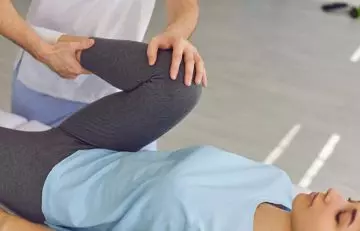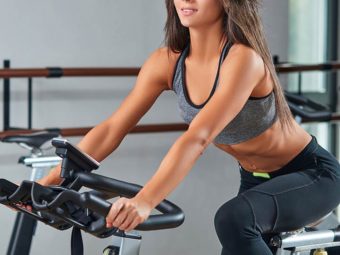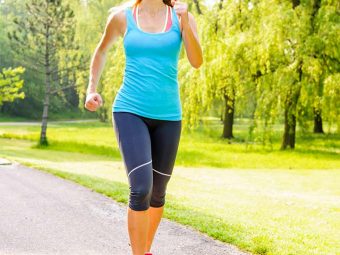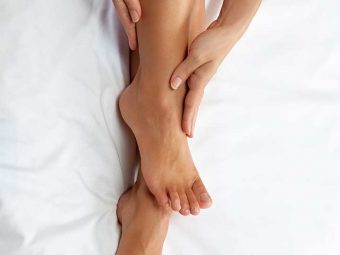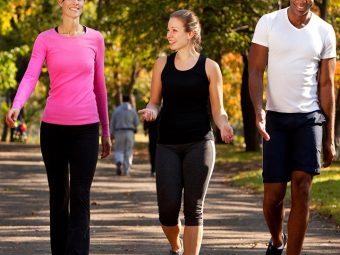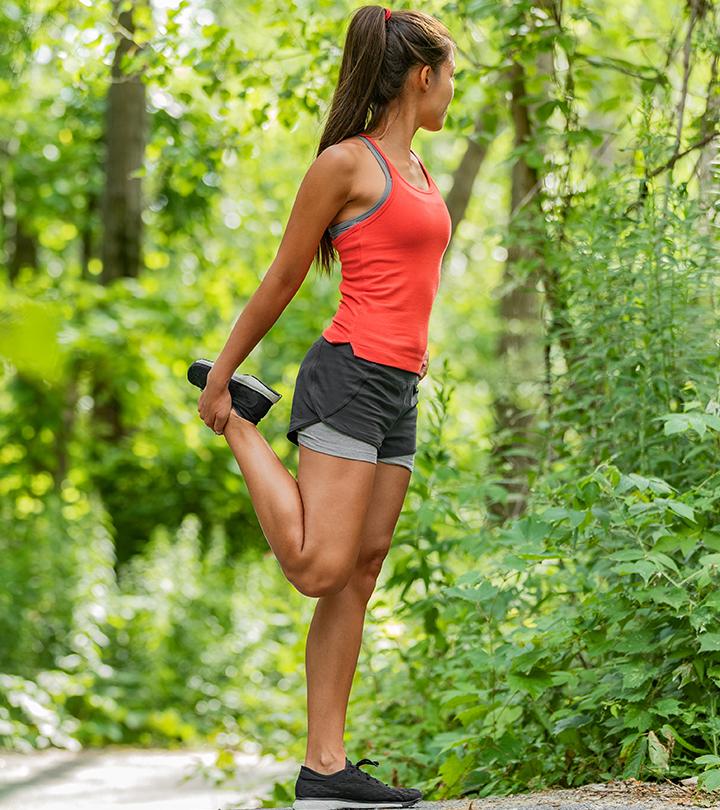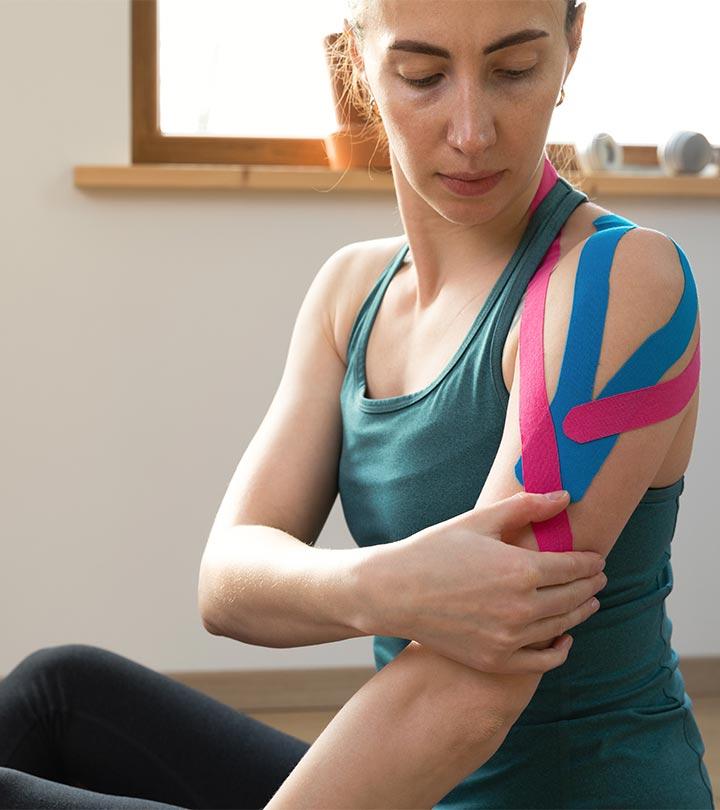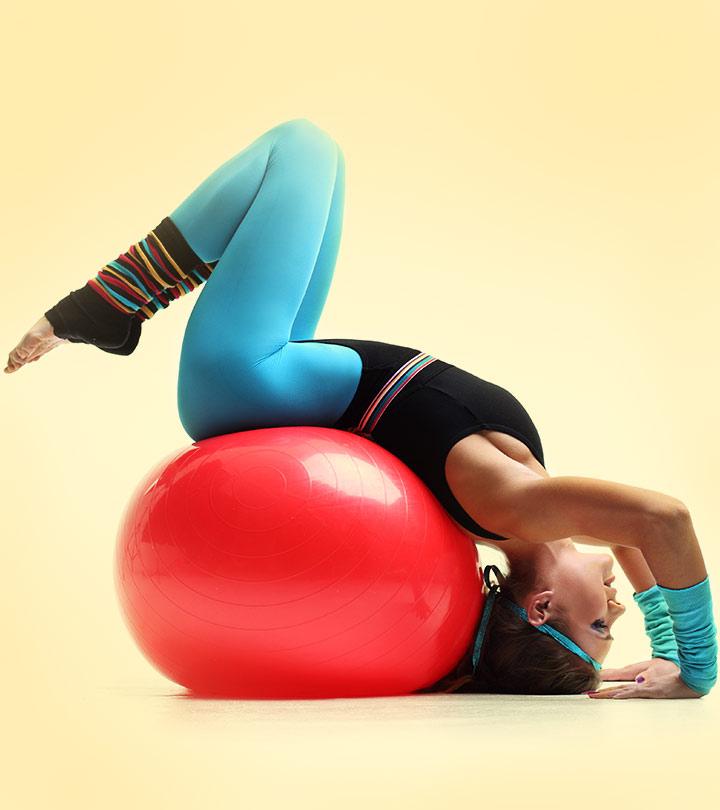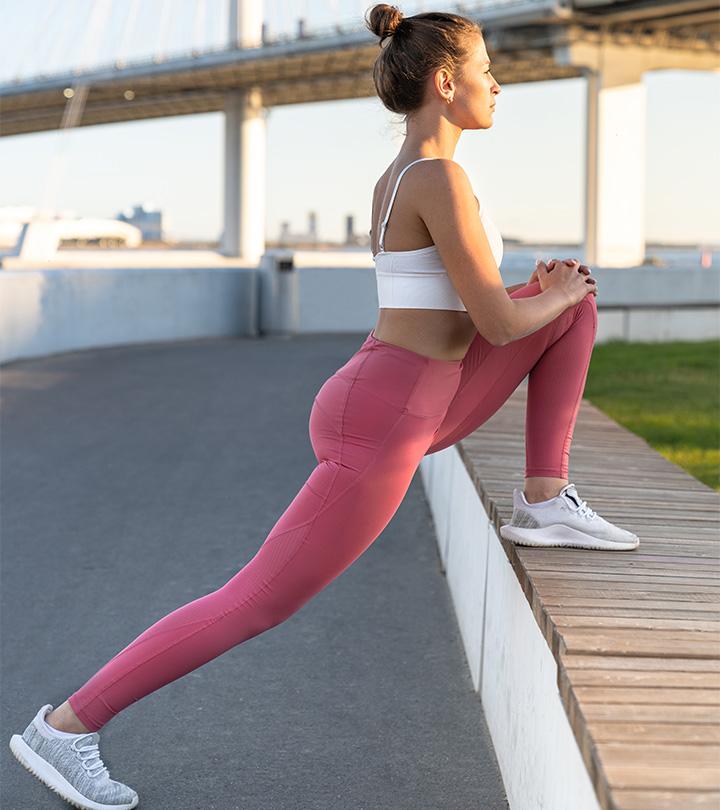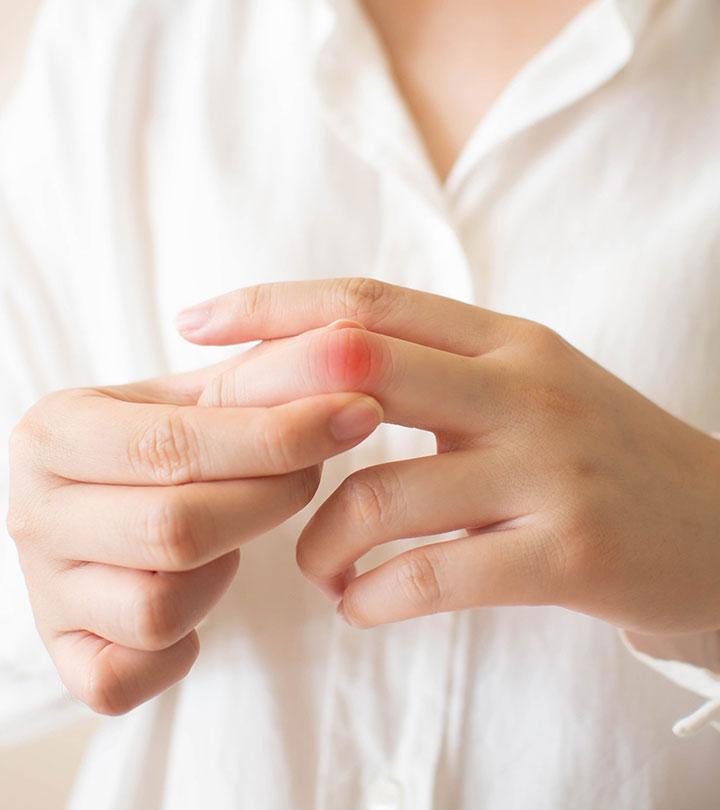14 Amazing Benefits Of Walking And Useful Tips
This aerobic exercise is your one-stop solution to manage hypertension and heart ailments.
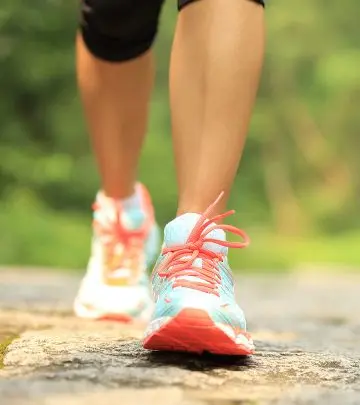
Image: Shutterstock
Walking is a great aerobic exercise and an effective way to kick start your metabolismi XChemical reactions in the cells that convert food into energy required by the body to perform basic functions. . According to the journal Medicine and Science in Sports and Exercise, walking helps reduce the prevalence of chronic diseases (1). In fact, walking (at speeds equal to or greater than 8 km/h) expends more energy than jogging at the same speed (2). Read on to find out about the health benefits of walking daily.
 Workout Blueprint: Walking
Workout Blueprint: Walking- Frequency: Daily
- Benefits: Aids weight loss, increases lung capacity, and regulates blood pressures that improves heart health.
- Equipment Needed: No
- Space Required: Large space
- Assistance Required: No
- Who Should Avoid: Anyone with a chronic medical condition or joint issue.
In This Article
Health Benefits Of Walking
1. Aids Weight Loss

Walking is an effective way to burn calories and lose weight.
Researchers at the University of Alabama designed an experiment that involved obese patients walking together (a concept known as the ‘walking bus’) to their destinations in and around the city. After eight weeks, their weight was checked, and more than 50% of the participants lost an average of 5 pounds (3).
 Fun Fact
Fun FactWalking also increases energy expenditure and is an effective and inexpensive way to burn calories (4).
2. Improves Heart Health
Walking helps improve heart health. A study conducted on adult women in rural New York showed a positive correlation between walking and improved biomarkers of cardiovascular health (5).
Many studies also suggest that walking reduces the risk of cardiovascular events by 31%. As per the American Heart Association/American College of Sports Medicine guidelines, every adult should do moderate-intensity workout (like brisk walking) for at least 30 minutes a day, five days a week (6).
A study published in the British Journal of Sports Medicine suggests that just 11 minutes of moderate-intensity activity like brisk walking can reduce the risk of heart disease and stroke. Accumulating 75 minutes per week of moderate-intensity activity was associated with a 23% lower risk of early death and reductions in cardiovascular disease and cancer risks.
3. Regulates Blood Pressure

Walking can also help lower blood pressure by improving circulation.
Researchers at the Wakayama Medical College, Japan conducted an experiment on individuals with mild hypertension, where 83 participants walked 10,000 steps per day for 12 weeks. At the end of 12 weeks, they showed a significant drop in blood pressure and had increased stamina (7).
If you are unable to complete 10,000 steps per day, walk for at least 30 minutes every day to keep your blood pressure levels in check.
4. Regulates Blood Glucose Levels
Going on short walks on a regular basis can help improve fasting and post-meal blood glucose levels.
Scientists recommend no less than 5,000 steps a day – with more than 3,000 of those steps being a brisk walk – to help manage type 2 diabetes (8).
A small study done on inactive seniors (>60 years of age) with blood glucose levels of 105-125 mg/dL demonstrated that short interval walking for 15 minutes or 45 minutes after meals (breakfast, lunch, and dinner) controlled post-meal glucose response (9).
5. Strengthens Bones And Eases Joint Movements
Regular walking showed improved bone health through the improvement in lubrication between joints and strengthening and toning of your muscles. Apart from improved joint health, walking also leads to improved flexibility, posture, and balance.
A small study done on 27 people with symptomatic knee osteoarthritisi XThe most common form of arthritis, it is a degenerative joint disease that causes the tissues in the joint to deteriorate over time. showed that walking at a stretch for 30 minutes or more increased knee pain while the same volume of walking in multiple boutsi XA period in which someone experiences a condition or suffers from something, such as an illness or disease. improved knee loading and eased pain (10).
6. Increases Lung Capacity
Walking can also increase your lung capacity. When you walk, you breathe in more oxygen as compared to when you are stationary. This exchange of oxygen and carbon dioxide at a larger volume can help increase your lung capacity, thereby increasing your stamina and exercise performance.
A study published in The European Respiratory Journal found that aerobic fitness could help increase lung volume (11).
7. Boosts Immune Functions
Walking helps reduce frequent attacks of infection and boosts immunity. A study was conducted at Duke University School of Medicine on twelve sedentary adults with stable rheumatoid arthritis.
The participants were asked to walk on a treadmill for 30 minutes, thrice a week for 10 weeks. They showed improved immune function and infection risk at the end of the study (12).
8. Improves Gastrointestinal Function
Apart from maintaining good food habits and drinking water, you should also walk to improve gastrointestinal function.
Studies have shown that low-impact exercise has a protective role in gastrointestinal disorders. It improves gastrointestinal motility and blood flow in the gastrointestinal tract. However, there is limited evidence on its effect on irritable bowel syndrome (IBS) and constipation (13).
9. Uplifts Mood
Several scientific studies have linked physical activity benefits with reduced risk of depression (14). Walking is highly recommended by physicians and psychiatrists as it leads to better sleep quality and improved mood.
Matt D’Avella, a YouTuber, took a 30-day challenge to walk 10,000 steps every day because of the sedentary lifestyle. He said, “I feel a lot better. I do. I feel a lot better now that I have gotten this extra cardio in, even if that cardio was as simple as walking more (i).”
10. Reduces Stress
Walking has various mental health benefits. It can help reduce stress levels by improving circulation, which, in turn, provides nutrients and oxygen to the cells. It also stimulates the nervous system receptors and decreases the production of stress hormones.
A randomized study conducted at the Medical University of Graz (Austria) found that walking combined with resting and balneotherapy (bath therapy) helped reduce stress (15).
11. Improves Memory
Walk every day to give your memory power a boost. Japanese scientists have found that walking can lead to improved cognitive function in older patients (16).
It has also been found that physical exercise helps increase the size of the hippocampusi XA part of the brain that can be found in the inner folds of the bottom middle region, mostly involved with learning and memory. , while a sedentary lifestyle shrinks the hippocampus, leading to memory loss (17).
12. Improves Mortality
The duration and intensity of walking affect the mortality rate. A study conducted on 1239 men found that walking for 1-2 hours a day decreased mortality risk by 70% in men with cardiovascular disease, cerebrovascular disease, or cancer. However, walking for more than 2 hours showed no significant benefits in these men (18).
13. May Improve Fertility
Some research done on physical activity and fertility in females suggests that walking may have some benefit. Increased walking was associated with a higher fertility in women with a BMI over 25 kg/m2 (19). However, a few other studies suggest no link between walking and improved fertility.
It could be assumed that walking, when combined with other healthy lifestyle changes, may potentially help boost fertility in women. That said, more concrete research is warranted in this regard.
14. May Benefit Varicose Veins
Walking is a low-impact exercise that can help improve blood circulation (20). This can help reduce symptoms of varicose veins, like pain and swelling, by promoting healthy blood flow in the legs. Walking also seems to help by lowering blood pressure in the veins.
However, make sure to not walk for too long. Too much exercise or exertion may put pressure on the veins and aggravate the condition.
Have all these benefits motivated you to start walking daily? Check out the next section to find out what you need to start doing this simple exercise every day.
What Do You Need to Start Walking?
You need a few basic things to walk. Here’s the list:
- Walking shoes
- Comfortable clothes
- A bottle of water and an energy bar for long walks
- If you walk to your office, wear your office clothes and a pair of comfortable shoes. You can change your footwear later at the office.
- Waterproof jacket
- Motivation – Absolutely necessary for at least the first 5 days.
- A pedometer to track your walking goals.
How To Stay Motivated For Walking
- Ask a friend to join you in your new exercise routine.
- Walk your dog in the morning or evening.
- Go for a stroll with your friends or family in the evening or after dinner.
- Walk to your nearest grocery store or a nearby place.
- Think about the money you can save by walking.
- Use a walking planner to find out the best walking route, measure heart rate, calories burned, count steps, etc.
- Explore different paths every day.
- Join a walking group.
- Go on hiking trips.
- Walk for a social cause.
 Did You Know?
Did You Know?Useful Tip
If you are new to walking, you cannot walk for long distances immediately. Break up your walking routine. Start by walking 10 minutes every day. Gradually increase this duration to 30 minutes a day. Then, you can walk for 30 minutes in the morning and 30 minutes in the evening. Also, gradually increase the pace of your walking. After walking, stretch your leg and calf muscles for 20 seconds to cool down the activated muscles.
Infographic: The Top 4 Advantages of Walking
Are you one of the numerous individuals who started walking as exercise? Walking is not only beneficial for your health and well-being, but it’s also cheap, simple, and convenient. In addition to being a better option for the environment than driving or using public transportation, it may be a terrific way to explore your neighborhood. See the infographic below to discover more about the health advantages of walking and get started right away. Illustration: StyleCraze Design Team
The benefits of walking are quite innumerable. It helps enhance your metabolism, lower cholesterol levels and set the stage clear for better weight management. Regular walking can lead to improved heart health and minimized risk of cardiovascular ailments. Moreover, this aerobic exercise also leads to reduced risk of chronic diseases, such as hypertensioni XAn abnormally high blood pressure level that increases the risk of heart disease, stroke, and other serious health problems. (by increasing blood circulation) and diabetes (by controlling blood sugar levels) and allows you to get a toned and fitter body with stronger bones. Remember, you must walk at least 10,000 steps a day, and do not forget to do warm-up exercises before and after walking for improved balance and to reduce the risk of injuries.
Frequently Asked Questions
Is walking good for you?
Yes, walking is good for you as it is an aerobic exercise that burns calories, leads to improved circulation, and makes you feel energized. If you are a beginner, start walking for 30 minutes at a slow pace and increase the time and intensity every day.
Is too much walking harmful?
Yes. You should always aim to do aerobic exercises, like walking, for no more than 1-2 hours a day. Regular walking for short intervals can lead to increased energy levels and improved posture. However, walking for more than 2 hours may strain your knees and legs and exhaust your energy.
Is walking better than running?
Walking has more benefits compared to running. As walking is a low-to-moderate intensity aerobic exercise, it helps you lose weight, improves your heart health, and leads to improved lung function. However, running burns more calories and aids weight loss.
How much walking is enough exercise?
You should aim to walk 1 hour a day at a speed of around 6 km/hr to improve your health.
Can I get in shape by walking?
Getting in shape means you need to focus more on losing inches. Walking offers overall health benefits, but to get in shape, you need to combine aerobic exercises like walking with strength training.
Does walking reduce belly fat?
Yes. Regular walking can help reduce visceral body fat (fat stored deep inside the belly) (21).
Does walking tone your legs?
Yes. Aerobic exercises like walking can help tone your legs (22).
Is walking better than the gym?
Yes. Walking is an effective and more convenient way for weight loss and health when compared to a gym (23).
Key Takeaways
- Walking is a great form of aerobic exercise. It can help you manage your blood glucose and lower blood pressure levels.
- Regular walking can significantly reduce the risk of cardiovascular diseases.
- Walking reduces joint pain and is thus highly beneficial for people with osteoarthritis.
- Walking leads to reduced stress and an improved immune system.

Image: Dall·E/StyleCraze Design Team
Walking builds stamina, burns calories, and improves overall health. Check out this video to find out about the many benefits of walking daily.
Personal Experience: Source
StyleCraze's articles are interwoven with authentic personal narratives that provide depth and resonance to our content. Below are the sources of the personal accounts referenced in this article.
i. I walked 10,000 steps a day for 30 dayshttps://www.youtube.com/watch?v=0URr_XkgAIE
References
Articles on StyleCraze are backed by verified information from peer-reviewed and academic research papers, reputed organizations, research institutions, and medical associations to ensure accuracy and relevance. Read our editorial policy to learn more.
- The importance of walking to public health, Medicine and Science in Sports and Exercise, US National Library of Medicine, National Institutes of Health.
https://www.ncbi.nlm.nih.gov/pubmed/18562968 - Energy expenditure during walking and jogging, The Journal of Sports Medicine and Physical Fitness, US National Library of Medicine, National Institutes of Health.
https://www.ncbi.nlm.nih.gov/pubmed/11296999 - Walking Programs to Promote Weight Loss among Obese and Overweight Individuals: Walking Buses for Adults, Public Health, US National Library of Medicine, National Institutes of Health.
https://www.ncbi.nlm.nih.gov/pmc/articles/PMC4754299/ - Energy expenditure comparison between walking and running in average fitness individuals, Journal of Strength and Conditioning Research, US National Library of Medicine, National Institutes of Health.
https://www.ncbi.nlm.nih.gov/pubmed/22446673 - Walking for Heart Health: A Study of Adult Women in Rural New York, Creative Nursing, US National Library of Medicine, National Institutes of Health.
https://www.ncbi.nlm.nih.gov/pubmed/29195541 - Walking: Your Steps to Health, Harvard Health Publishing, Harvard Medical School.
https://www.health.harvard.edu/heart-health/step-up-your-walking-game - Walking 10,000 steps/day or more reduces blood pressure and sympathetic nerve activity in mild essential hypertension,Hypertension Research, US National Library of Medicine, National Institutes of Health.
https://www.ncbi.nlm.nih.gov/pubmed/11131268 - Steps to Preventing Type 2 Diabetes: Exercise, Walk More, or Sit Less?, Frontiers in Endocrinology, US National Library of Medicine, National Institutes of Health.
https://www.ncbi.nlm.nih.gov/pmc/articles/PMC3500773/ - Three 15-min Bouts of Moderate Postmeal Walking Significantly Improves 24-h Glycemic Control in Older People at Risk for Impaired Glucose Tolerance, Diabetes Care, American Diabetes Association.
https://care.diabetesjournals.org/content/early/2013/06/03/dc13-0084 - The Influence of Continuous Versus Interval Walking Exercise on Knee Joint Loading and Pain in Patients with Knee Osteoarthritis, Gait & Posture, US National Library of Medicine, National Institutes of Health.
https://www.ncbi.nlm.nih.gov/pmc/articles/PMC5669616/ - Does physical fitness enhance lung function in children and young adults?The European Respiratory Journal, US National Library of Medicine, National Institutes of Health.
https://www.ncbi.nlm.nih.gov/pubmed/29386347 - Ten weeks of high-intensity interval walk training is associated with reduced disease activity and improved innate immune function in older adults with rheumatoid arthritis: a pilot study, Arthritis Research & Therapy, US National Library of Medicine, National Institutes of Health.
https://www.ncbi.nlm.nih.gov/pmc/articles/PMC6001166/ - Potential benefits and hazards of physical activity and exercise on the gastrointestinal tract, Gut, US National Library of Medicine, National Institutes of Health.
https://www.ncbi.nlm.nih.gov/pmc/articles/PMC1760153/pdf/v048p00435.pdf - Physical activity and the prevention of depression: a systematic review of prospective studies, American Journal of Preventive Medicine, US National Library of Medicine, National Institutes of Health.
https://www.ncbi.nlm.nih.gov/pubmed/24139780 - Combining walking and relaxation for stress reduction-A randomized cross-over trial in healthy adults, Stress and Health, US National Library of Medicine, National Institutes of Health.
https://www.ncbi.nlm.nih.gov/pubmed/28840638 - Six-Minute Walking Distance Correlated with Memory and Brain Volume in Older Adults with Mild Cognitive Impairment: A Voxel-Based Morphometry Study, Dementia and Geriatric Cognitive Disorders Extra, US National Library of Medicine, National Institutes of Health.
https://www.ncbi.nlm.nih.gov/pmc/articles/PMC3776400/ - Exercise training increases size of hippocampus and improves memory, Proceedings of the National Academy of Sciences of the United States of America, US National Library of Medicine, National Institutes of Health.
https://www.ncbi.nlm.nih.gov/pmc/articles/PMC3041121/ - Health Benefits of Daily Walking on Mortality Among Younger-Elderly Men With or Without Major Critical Diseases in the New Integrated Suburban Seniority Investigation Project: A Prospective Cohort Study, Journal of Epidemiology, US National Library of Medicine, National Institutes of Health.
https://www.ncbi.nlm.nih.gov/pmc/articles/PMC4626390/ - Physical activity and fertility
https://www.ncbi.nlm.nih.gov/pmc/articles/PMC7614776/#R38 - Chronic venous insufficiency and varicose veins of the lower extremities
https://www.ncbi.nlm.nih.gov/pmc/articles/PMC6406103/ - A dose-response relation between aerobic exercise and visceral fat reduction: systematic review of clinical trials, US National Library of Medicine, National Institutes of Health.
https://pubmed.ncbi.nlm.nih.gov/17637702/ - An analysis on muscle tone of lower limb muscles on flexible flat foot, Journal of Physical Therapy Science.
https://www.researchgate.net/publication/283555957_An_analysis_on_muscle_tone_of_lower_limb_muscles_on_flexible_flat_foot - Exercise in the Park or Gym? The Physiological and Mental Responses of Obese People Walking in Different Settings at Different Speeds: A Parallel Group Randomized Trial, Frontiers in Psychology, US National Library of Medicine, National Institutes of Health.
https://www.ncbi.nlm.nih.gov/pmc/articles/PMC8569935/





